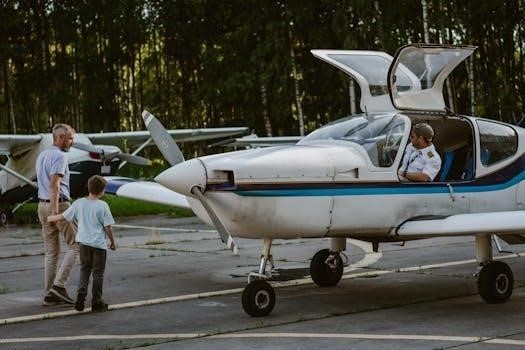Guided Flight Discovery⁚ An Overview
Guided Flight Discovery (GFD) is a comprehensive pilot training system focusing on an application-oriented approach. It moves beyond mere fact memorization, emphasizing the practical use of knowledge, with updated content and innovative graphics for better understanding.
Guided Flight Discovery (GFD) represents a modern and comprehensive approach to pilot training. It’s designed to provide aspiring pilots with a deep understanding of aviation principles, going beyond rote memorization. GFD emphasizes the practical application of knowledge, ensuring students not only know the ‘what’ but also the ‘how’ and ‘why’ behind flight operations. This system utilizes the latest in educational techniques, combining updated content with innovative graphics and design elements, making complex subjects more accessible and engaging. The core of GFD is its focus on building a solid foundation of aeronautical knowledge, fostering critical thinking, and preparing students for the challenges and rewards of flying. It aims to instill not just the skills, but also the judgment and decision-making capabilities essential for safe and proficient piloting. GFD also integrates real-world scenarios and examples, ensuring that the learning process is both relevant and applicable to actual flight experiences.
Core Principles of Guided Flight Discovery
The core principles of Guided Flight Discovery (GFD) revolve around an application-oriented approach, moving past traditional rote learning. GFD prioritizes understanding over memorization, ensuring pilots can apply their knowledge in real-world flight situations. The system emphasizes building a robust foundation of aeronautical knowledge, achieved through a logical progression of topics that build upon each other. It integrates innovative design techniques, such as Discovery Insets and Human Element Insets, to enhance understanding and engage students. GFD also stresses the importance of critical thinking and decision-making, crucial aspects of safe and proficient piloting. The material is organized to promote a deeper understanding of complex concepts. GFD also incorporates up-to-date information, ensuring students are aware of the latest advancements in flight operations and technology. This approach to learning is designed to make training not just effective but also enjoyable and relevant, fostering a genuine passion for aviation. The system’s emphasis is on producing competent and safe pilots, well-prepared for their future in aviation.

Key Components of Guided Flight Discovery
The Guided Flight Discovery system includes a Private Pilot textbook with updated content, a maneuvers manual, and a flight instructor manual. These components work together to provide a complete training experience.
Private Pilot Textbook Features
The Private Pilot textbook within Guided Flight Discovery offers complete and concise explanations of essential concepts for aspiring pilots. Its intuitive organization and colorful presentation enhance the learning experience. The textbook incorporates new sections on ATC services, GPS navigation, airspace, flight information sources, and cross-country flying. It also introduces the latest developments in flight operations, such as ADS-B and the FAA’s NextGen system, alongside digital instrument displays. Unique design techniques are employed, with hundreds of graphics and photos included to aid comprehension. Subjects are presented in a logical order, building upon previously introduced topics. Discovery Insets are strategically placed throughout the chapters to expand upon key concepts, making it an essential study aid for anyone on their journey to becoming a private pilot. This manual is designed to make learning fun and easy, ensuring that students grasp the fundamentals effectively.
Maneuvers Manual in Guided Flight Discovery
The Maneuvers Manual, a key component of Guided Flight Discovery, provides comprehensive explanations of essential flight maneuvers for private pilots. This manual focuses on practical application, offering detailed guidance for mastering each maneuver. The content is presented clearly with the use of colorful illustrations and photos to enhance understanding. It serves as a practical guide for both students and instructors, ensuring a solid grasp of required flight techniques. Specifically, the manual covers essential maneuvers, explaining each step with precision and clarity. This ensures that pilots develop the necessary skills and confidence to perform these maneuvers safely and effectively; The manual is designed to be a reliable resource for flight training, complementing the textbook and other GFD materials. Its focus on practical techniques and clear explanations makes it an invaluable tool for pilot training.
Flight Instructor Manual and its Role
The Flight Instructor Manual within Guided Flight Discovery is a comprehensive resource designed to equip instructors with the necessary tools and knowledge. It provides detailed explanations of training techniques essential for both new and seasoned Certified Flight Instructors (CFIs). This manual is enriched with over 1,000 full-color photos and illustrations, making complex concepts easier to grasp. It emphasizes real-world scenarios and examples, ensuring that instructors are well-prepared to guide their students. The manual’s role is to facilitate effective teaching methods, promoting a deep understanding of aeronautical concepts. It is a vital tool for turning a passion for flying into a profession by providing clear, concise, and relevant information for effective instruction. Furthermore, it guides instructors in using a structured approach to training, based on proven techniques. This ensures consistency and quality in flight training, helping to produce competent and confident pilots.

Learning Experience and Techniques
Guided Flight Discovery employs discovery insets and human element insets to expand knowledge and understanding. It uses an application-oriented approach and the 5P checklist for flight planning, enhancing the learning process.
Discovery Insets and Human Element Insets
Within the Guided Flight Discovery system, the use of Discovery Insets and Human Element Insets plays a crucial role in enhancing the learning experience. Discovery Insets are strategically placed throughout the chapters of the textbooks, serving as a means to expand a student’s knowledge of specific subjects and the broader world of aviation. These insets delve into interesting aspects of flight, often providing additional context and real-world examples that go beyond the core curriculum. They encourage curiosity and exploration, making learning more engaging and memorable.
Complementing the Discovery Insets, the Human Element Insets focus on the crucial area of human factors in aviation. These insets address how the mind and body function during flight, covering topics such as stress management, decision-making, and situational awareness; By understanding these principles, students gain valuable insight into how their own performance can be affected, and how to mitigate potential risks. The combination of these two types of insets enriches the learning process, providing a more holistic understanding of aviation.
Application-Oriented Approach to Pilot Training
The Guided Flight Discovery system distinguishes itself through its strong emphasis on an application-oriented approach to pilot training. Rather than simply presenting facts and theories, this method focuses on enabling students to understand the practical implications of what they learn and apply that knowledge effectively in real-world flight scenarios. The core idea is to move beyond rote memorization and encourage active learning, where students are challenged to think critically about how concepts translate into actual flight operations. This approach helps students develop the skills and judgment needed to become competent and confident pilots.
This method ensures that students are not just passively absorbing information but are actively engaging with the material, understanding the ‘why’ behind each procedure and maneuver. The content is structured to build upon previously introduced topics, creating a logical progression that prepares students for advanced flight training. Through Discovery Insets and real-world examples, the system enhances comprehension and allows students to connect the dots between theory and practice. This approach provides a more effective and lasting learning experience.
The 5P Checklist for Flight Planning
The 5P checklist, an integral part of the Guided Flight Discovery system, offers a structured approach to mitigate risks during flight planning. This checklist encourages pilots to systematically evaluate critical factors before each flight. The first ‘P’ stands for ‘Pilot’, where personal aspects such as training, experience, and fitness are assessed. Next, ‘Passengers’ prompts consideration of their experience, flexibility, and any specific needs they may have. The third ‘P’ represents ‘Plane’, requiring an evaluation of the aircraft’s airworthiness, performance, and configuration.
The fourth ‘P’, ‘Programming’, is also associated with planning. It involves ensuring that navigational instruments, and other aircraft systems are correctly set up for the intended route. Lastly, ‘Plan’ refers to the overall flight plan, including weather conditions, fuel requirements, and potential alternates. The 5P checklist helps the pilot to systematically consider all aspects of their flight, thereby reducing the likelihood of unforeseen issues and enhancing overall safety. It is a key component of flight preparation.

Practical Aspects of Guided Flight Discovery
Guided Flight Discovery offers practical experiences like discovery flights for introductory learning. It uses various training techniques, and integrates technology to enhance pilot training, focusing on real-world application.
Discovery Flights and Introductory Experiences
A discovery flight, often called an introductory flight, serves as a personalized gateway into the world of aviation. It’s a hands-on experience where aspiring pilots get to sit in the cockpit and experience flight firsthand. During these flights, a certified instructor guides the participant, explaining the basics of flight controls and aircraft operation. This initial experience allows individuals to grasp the fundamentals of flying, offering a practical understanding that complements theoretical learning. Discovery flights are designed to be accessible and engaging, ensuring a comfortable and informative first flight. Participants often get the chance to take the controls, under the supervision of the instructor, providing an exciting and memorable introduction. These flights offer a taste of what pilot training entails, helping people determine if pursuing flight training is a suitable path for them. It’s an opportunity to witness aviation from a pilot’s perspective, sparking interest and enthusiasm for flight.
Training Techniques and Methods
Guided Flight Discovery employs various training techniques and methods to facilitate effective pilot education. The system emphasizes an application-oriented approach, focusing on how knowledge is used in real-world flight situations rather than just memorizing facts. Training materials are closely coordinated, ensuring a seamless learning progression. Discovery Insets and Human Element Insets are strategically integrated throughout the curriculum, enhancing understanding of aviation concepts and human factors. Instructors provide guidance, correct errors, and ensure safety during training flights. The training incorporates real-world scenarios and examples, making learning more relevant and engaging. The teaching method builds upon previously mastered material, reinforcing understanding. The curriculum uses colorful illustrations, photos, and design techniques to make learning more accessible. The system aims to not only impart knowledge, but also to cultivate the practical skills needed for safe and proficient flying, with continuous instructor support and encouragement.

Integration of Technology in Flight Training
The Guided Flight Discovery program integrates modern technology to enhance flight training. The latest versions of textbooks incorporate information on contemporary advancements like ADS-B, the FAA’s NextGen system, and digital instrument displays. This ensures students are well-versed in current aviation technology. The use of intuitive organization and colorful presentations, along with numerous graphics and photos, aids in understanding complex subjects. Students are introduced to electronic flight instruments, which are increasingly common in modern aircraft. The integration of technology extends to navigation, with sections on GPS navigation and flight information sources. This approach prepares students for the technology they will encounter in real-world flying. Furthermore, the use of digital resources and multimedia elements, such as animations corresponding to key concepts, makes the learning experience more engaging and effective. The program adapts to technological advancements, ensuring that students are equipped with the knowledge and skills needed to operate in a technologically advanced aviation environment.
